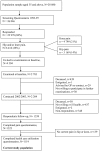Help-seeking behaviour among people living with chronic hip or knee pain in the community
- PMID: 19968876
- PMCID: PMC2793247
- DOI: 10.1186/1471-2474-10-153
Help-seeking behaviour among people living with chronic hip or knee pain in the community
Abstract
Background: A large proportion of people living with hip or knee pain do not consult health care professionals. Pain severity is often believed to be the main reason for help seeking in this population; however the evidence for this is contradictory. This study explores the importance of several potential risk factors on help seeking across different practitioner groups, among adults living with chronic hip or knee pain in a large community sample.
Methods: Health care utilization, defined as having seen a family doctor (GP) during the past 12 months; or an allied health professional (AHP) or alternative therapist during the past 3 months, was assessed in a community based sample aged 35 or over and reporting pain in hip or knee. Adjusted odds ratios were determined for social deprivation, rurality, pain severity, mobility, anxiety/depression, co-morbidities, and body mass index.
Results: Of 1119 persons reporting hip or knee pain, 52% had pain in both sites. Twenty-five percent of them had seen a doctor only, 3% an AHP only, and 4% an alternative therapist only. Thirteen percent had seen more than one category of health care professionals, and 55% had not seen any health care professional. In the multivariate model, factors associated with consulting a GP were mobility problems (OR 2.62 (1.64-4.17)), urban living (OR 2.40 (1.14-5.04) and pain severity (1.28 (1.13-1.44)). There was also some evidence that obesity was associated with increased consultation (OR 1.72 (1.00-2.93)). Factors were similar for consultation with a combination of several health care professionals. In contrast, seeing an alternative therapist was negatively associated with pain severity, anxiety and mobility problems (adjusting for age and sex).
Conclusion: Disability appears to be a more important determinant of help-seeking than pain severity or anxiety and depression, for adults with chronic pain in hip or knee. The determinants of seeking help from alternative practitioners are different from determinants of consulting GPs, AHPs or a combination of different health care providers.
Figures
Similar articles
-
What General and Pain-associated Psychological Distress Phenotypes Exist Among Patients with Hip and Knee Osteoarthritis?Clin Orthop Relat Res. 2020 Dec;478(12):2768-2783. doi: 10.1097/CORR.0000000000001520. Clin Orthop Relat Res. 2020. PMID: 33044310 Free PMC article.
-
The natural history of disability and its determinants in adults with lower limb musculoskeletal pain.J Rheumatol. 2009 Mar;36(3):583-91. doi: 10.3899/jrheum.080455. Epub 2009 Jan 22. J Rheumatol. 2009. PMID: 19208591
-
Obesity and increased burden of hip and knee joint disease in Australia: results from a national survey.BMC Musculoskelet Disord. 2012 Dec 20;13:254. doi: 10.1186/1471-2474-13-254. BMC Musculoskelet Disord. 2012. PMID: 23253742 Free PMC article.
-
Folic acid supplementation and malaria susceptibility and severity among people taking antifolate antimalarial drugs in endemic areas.Cochrane Database Syst Rev. 2022 Feb 1;2(2022):CD014217. doi: 10.1002/14651858.CD014217. Cochrane Database Syst Rev. 2022. PMID: 36321557 Free PMC article.
-
Behavioural modification interventions for medically unexplained symptoms in primary care: systematic reviews and economic evaluation.Health Technol Assess. 2020 Sep;24(46):1-490. doi: 10.3310/hta24460. Health Technol Assess. 2020. PMID: 32975190 Free PMC article.
Cited by
-
Annual incidence rates of hip symptoms and three hip OA outcomes from a U.S. population-based cohort study: the Johnston County Osteoarthritis Project.Osteoarthritis Cartilage. 2016 Sep;24(9):1518-27. doi: 10.1016/j.joca.2016.04.012. Epub 2016 Apr 21. Osteoarthritis Cartilage. 2016. PMID: 27109873 Free PMC article.
-
What influences general practitioners' use of exercise for patients with chronic knee pain? Results from a national survey.BMC Fam Pract. 2016 Dec 19;17(1):172. doi: 10.1186/s12875-016-0570-4. BMC Fam Pract. 2016. PMID: 27993126 Free PMC article.
-
Why don't patients seek help for chronic post-surgical pain after knee replacement? A qualitative investigation.Health Expect. 2020 Oct;23(5):1202-1212. doi: 10.1111/hex.13098. Epub 2020 Jul 9. Health Expect. 2020. PMID: 32648336 Free PMC article.
-
Factors affecting health-seeking behavior in sports climbers in Metro Manila: a cross-sectional study.Front Sports Act Living. 2025 Feb 24;7:1514827. doi: 10.3389/fspor.2025.1514827. eCollection 2025. Front Sports Act Living. 2025. PMID: 40066059 Free PMC article.
-
Chronic pain after total knee arthroplasty.EFORT Open Rev. 2018 Aug 16;3(8):461-470. doi: 10.1302/2058-5241.3.180004. eCollection 2018 Aug. EFORT Open Rev. 2018. PMID: 30237904 Free PMC article.
References
-
- Peat G, Thomas E, Handy J, Wood L, Dziedzic K, Myers H, Wilkie R, Duncan R, Hay E, Hill J, Croft P. The Knee Clinical Assessment Study--CAS(K). A prospective study of knee pain and knee osteoarthritis in the general population. BMC Musculoskelet Disord. 2004;5:4. doi: 10.1186/1471-2474-5-4. - DOI - PMC - PubMed
-
- Sundén-Lundius A, Johnsson B, Lohmander S, Ekdahl C. Prevalence of self-reported hip disorders, relations to age, gender, pain, stiffness, weakness and other joint disorders. Advances in physiotherapy. 2005;7:108–113. doi: 10.1080/14038190510010395. - DOI
Publication types
MeSH terms
Grants and funding
LinkOut - more resources
Full Text Sources
Miscellaneous



